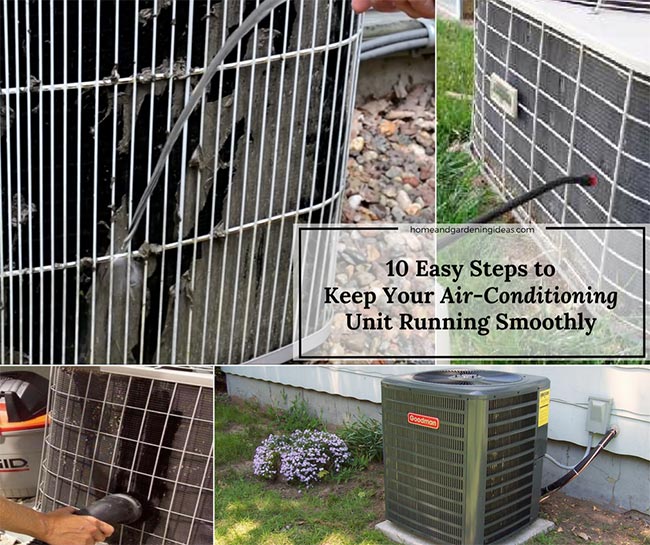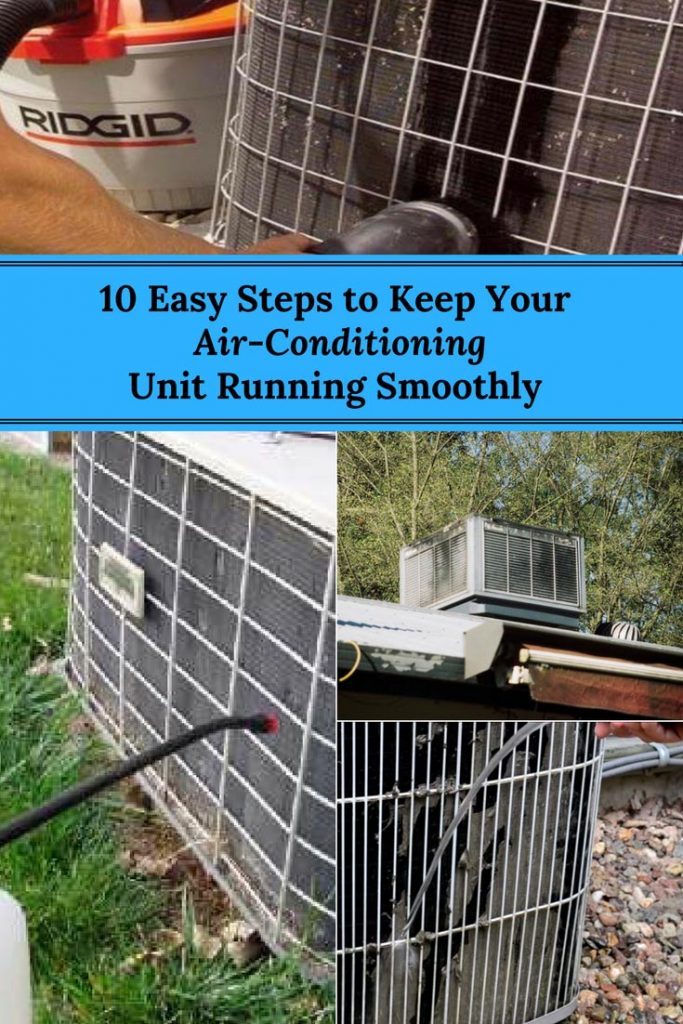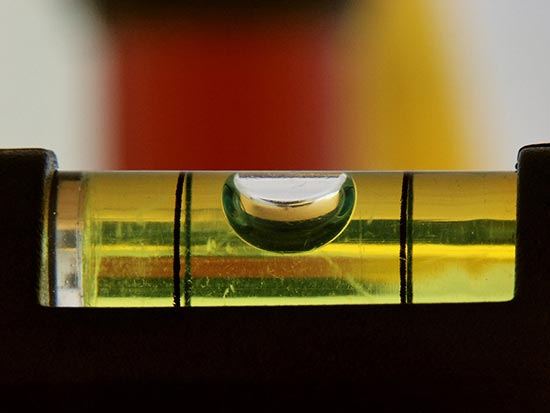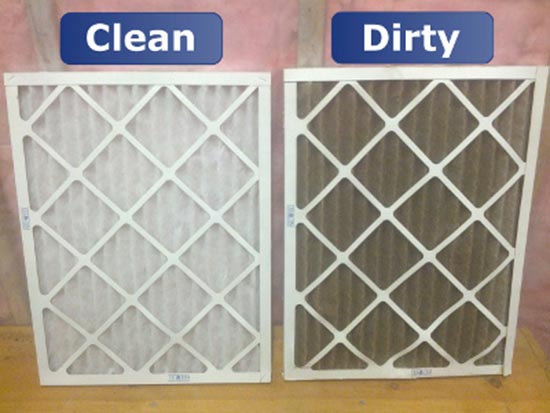10 Easy Steps to Keep Your Air-Conditioning Unit Running Smoothly

Regular cleaning and maintenance will save you money on your electric bill and on costly early replacement by extending the life of your HVAC unit or heat pump. An AC unit requires regular attention and servicing to be sure that it is operating as efficiently as possible and a clean AC unit uses approximately 30% less power than a dirty one. In addition to the financial incentive to keeping your unit running clean and efficiently, there is also a health incentive. An efficient AC unit prevents harmful pollutants from microbial contamination from being circulated throughout your house.
Your heating, ventilating, and air conditioning system (HVAC) consists of either a furnace and AC or a heat pump; a heat pump both heats and cools. Either way, your system will have both an exterior unit – condenser coil and compressor – and an interior unit – evaporator and blower motor.
Below, you’ll find step-by-step instructions for keeping your air conditioning unit running smoothly. These instructions apply to a heat pump unit or a home air conditioning unit. The best part is knowing that you don’t have to dip into your kids’ college funds to hire a professional when you can just do the job yourself by following these simple steps. And now is the time to do it, just before the new cooling season begins.
1) Turn off the power –
Turn off the power at the breaker box and also on the exterior condenser/compresser. It would be extremely dangerous to work around a live current and the air conditioner’s many moving parts.
2) Remove buildup and debris –
On the exterior condenser/compreser, use a screwdriver or wrench to remove the screws or other hardware attaching the fan cage or grill to the unit. Clean dust, leaves, grass clippings, and other debris from the interior of the condenser/compressor either using your hand or a wet/dry vacuum. HVAC units are often located near dryer vents, so they can accumulate a fair amount of dryer lint as well.
3) Clean the air conditioner condenser coils –
You don’t need anything but a garden hose and your thumb. Never use chemicals or pressure washers which are too strong and can damage the delicate fins on the unit. Simply spray the fins from the inside out to remove any built up debris or dirt. The whole process takes maybe ten minutes.
Doing this annually in spring or early summer could save you hundreds of dollars. In extreme cases of neglect, if the fins are particlarly dirty, you can use a commercially available cleaning spray. These sprays can be found at home improvement stores. The unit will kick on once the power is on again and dry itself off.
Carefully straighten fins that are bent out of shape. You can purchase a commercially available fin-straightening tool or just use a butter knife or similar thin tool. This requires finesse as you do not want to damage the tubing embedded in the fins. Bent fins restrict air flow and therfore retuce the efficiency of the unit.
5) Clean area around condenser unit –
Once your unit has been hosed and the fins combed, replace the fan’s grill and clean the area surrounding the unit to reduce future debris. Clip back any encroaching branches and vegetation and rake back leaves as needed. There should be roughly 2 feet of clear space in all directions surrounding the unit to maximize efficient airflow.
In cold months when the AC condenser is idle, consider covering the top of the unit to prevent leaves, branches, and other debris from falling in. You can use plastic or a piece of plywood, just be careful not to completely cover the sides. Simply remove the cover in the spring or whenever you turn on your air conditioning.

6) Level the unit –
As the soil settles underneath the condenser unit, the pad under the unit sometimes tips. When the condenser unit is not level, the compressor is more likely to fail prematurely. Get a level to check the condenser unit’s positioning, then use weather proof, rot-resistant shims to correct for incline.
The one exception you should be aware of is for heat pump systems. Pads underneath heat pump systems might have a strategic tilt to allow for defrost run-off to flow away from the home’s foundation during the winter.

7) Clean the evaporator coil –
You can now move inside to find the evaporator coil door inside the blower/furnace unit. There may be screws, bolts, and/or foil duct tape that needs to be removed in order for you to access the interior. Once the door is open, clean off the coil with a soft bristled brush and commercially available no-rinse coil cleaner. When you spray the cleaner, it will foam up and then it will drip into the drain pan. Don’t forget to clean out the drain pan as well.
Use hot water, soap, and a small amount of bleach. Finally, rince out the drain with a half and half mixture of water and bleach. As a final touch, you can leave a commercially available drain pan tablet in the drain pan to inhibit future algae growth and keep the drain clear for longer.
*Only follow step 8 if the bleach solution does not drain easily, indicating that your evaporator drain is clogged.*
Inside the evaporator drain, warm, humid air from inside the home encounters the cold coil which absorbs heat from the air and cools it before circulating it back into the home. Condensation forms on the evaporator coil and drips into the pan below.
The pan, in turn, drains into a tube. Often, mold and algae build up, blocking the drain. First, locate the drain line at the point where it leaves the evaporator coil enclosure. The drain is often a white, grey, or black 1-inch PVC pipe. Follow the pipe to where it drains and use a wet/dry vacuum to clear the drain.

10) Turn the power back on!
Thanks for checking out “10 Easy Steps to Keep Your Air-Conditioning Unit Running Smoothly”.
If you found this article interesting please consider sharing it on Facebook and Pinning it on your Pinterest boards, this will help spread the word and help hundreds of people see this info too, Also let me know in the comments below if you would like to add any more info to this article…
 Home and Gardening Ideas At home and Gardening ideas we believe inspiring readers about homesteading, self sufficiency
Home and Gardening Ideas At home and Gardening ideas we believe inspiring readers about homesteading, self sufficiency





